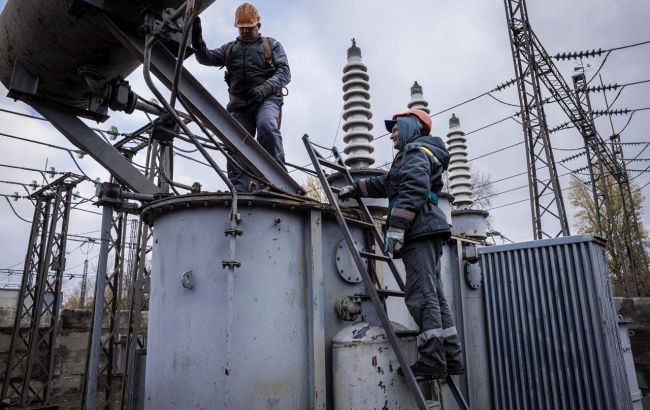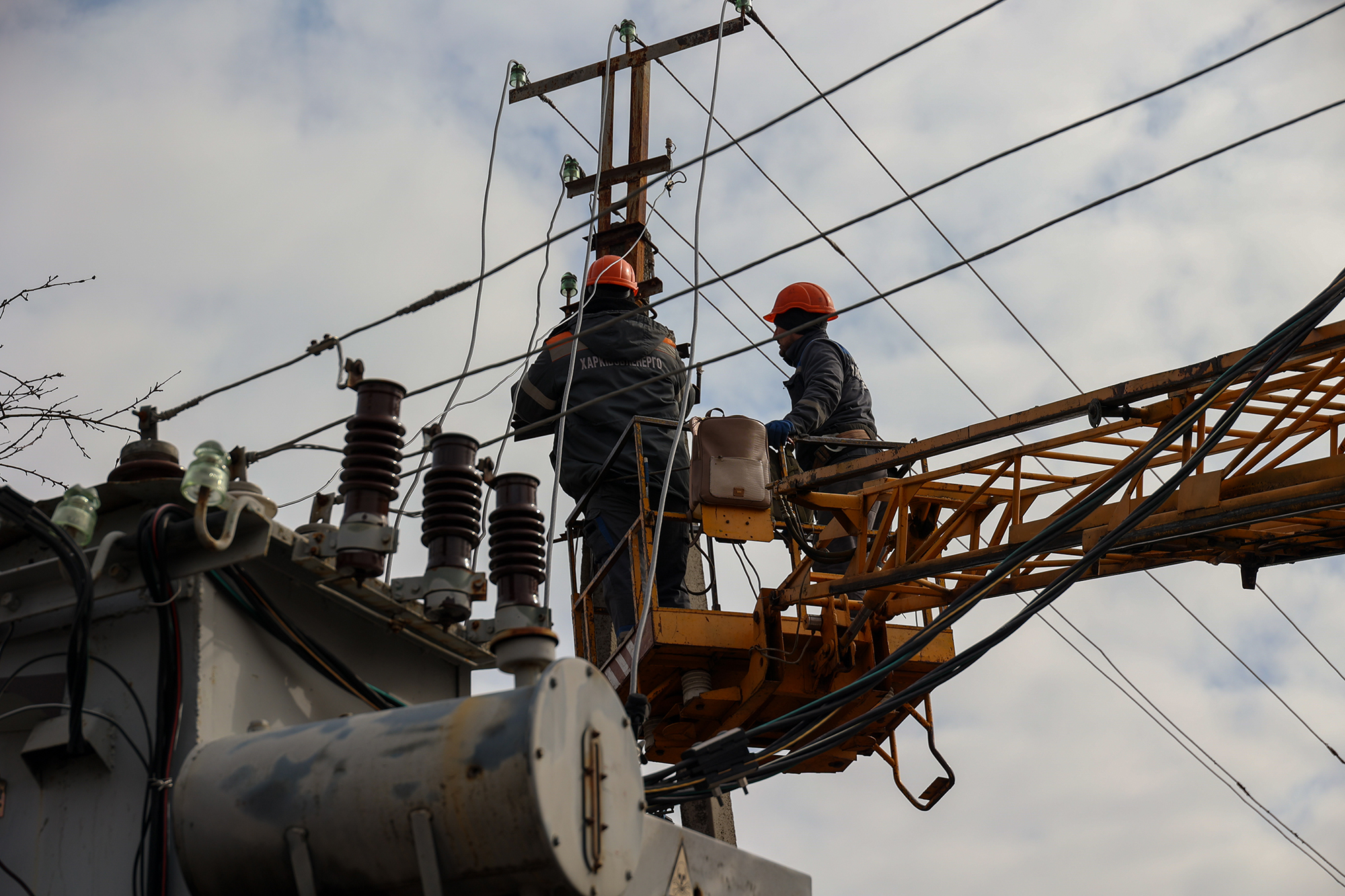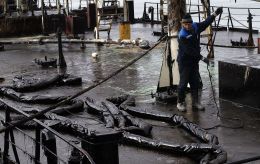Minus nuclear plant capacity in two weeks: What awaits Ukraine over Russian energy strikes
 Repair of energy facilities in Ukraine (photo: Getty Images)
Repair of energy facilities in Ukraine (photo: Getty Images)
After a new wave of massive Russian shelling, Ukraine's power system lost 6 GW of generation. This is equal to the capacity of Zaporizhzhia NPP seized by the Russians in February 2022. Experts do not rule out that in the future, Ukrainians will face an increase in electricity tariffs and the return of blackout schedules. Read more in the RBC-Ukraine article.
Almost two weeks of a new wave of Russian attacks on Ukraine's energy system have already caused more damage than the shelling of energy facilities during the last heating season. There is no clear answer as to why the Russians have intensified their attacks now and not in the winter. Experts and representatives of Ukrainian energy companies that RBC-Ukraine spoke to expressed different versions: ranging from the lack of Russian military capabilities in winter to the desire to reduce international resonance.
If energy facilities had been shelled during the freezing weather, the Ukrainian people would have found themselves in extremely difficult conditions with no electricity or heat. As a result, international partners could have stepped up their assistance to Ukraine, which would not have been in Russia's favor, a representative of a large energy company tells RBC-Ukraine. And now that spring is in full swing, Russian attacks on energy facilities are not provoking an active response in the world, although they are much more powerful than last year.
Russian tactics of shelling Ukrainian energy facilities changed
Since March 22, Russians have been conducting targeted attacks on energy facilities in most regions of Ukraine. As a result of damage to generation facilities and distribution networks, there are problems with power supply in Dnipropetrovsk, Donetsk, Kirovohrad, Odesa, Poltava, Sumy, and Kharkiv regions. The situation is most difficult in Kharkiv.
According to Ukrenergo and the Ministry of Energy, restoration work is underway in all affected regions, but the consequences cannot be fully eliminated for various reasons. In particular, some facilities are being hit again.
According to the latest reports, electricity supplies continue to be restricted in Dnipropetrovsk, Zaporizhzhia, Kirovohrad, Poltava, Sumy regions, and Kharkiv.
The Energy Ministry assures that there is no imbalance in the power system so far. "We are keeping the situation stable for now, but how it will develop further will depend on the shelling and its consequences," says Deputy Energy Minister Svitlana Hrinchuk.
.jpg) Work to restore power grids in Kharkiv (Photo: Getty Images)
Work to restore power grids in Kharkiv (Photo: Getty Images)
Last heating season, Russians launched 15 missile attacks and 18 drone attacks against Ukraine. About 1, 200 missiles and drones were fired at infrastructure facilities. More than 200 of them hit the target. 50% of power plants and more than 40% of power grids across the country were severely damaged. For comparison, in just two weeks of March-April this year, the Russian occupation forces launched about 3,000 guided aerial bombs, more than 600 kamikaze drones, and more than 400 missiles of various types on Ukraine.
According to Ukrenergo CEO Volodymyr Kudrytskyi, Russia uses combined missile and Shahed attacks to cause as much destruction as possible. "If we take, for example, the last heating season, we saw one massive attack, say, for a week, and it was a missile or Shahed attack. Now it's a whole series, almost continuous. And if we talk about the number of, for example, Shaheds, in just less than a decade and a half, this number has already reached the level we saw last heating season," says the head of Ukrenergo.
Oleksandr Kharchenko, Director of the Energy Research Center, notes that the Russians are now striking more focused at each facility, which increases the likelihood of defeat. The protection of the facilities, which was built last spring, helps, but it does not protect against ballistic missiles.
Losses from Russian attacks on heat generation doubled
According to Kudrytskyi, Ukrenergo's losses in the first days of the attacks alone amounted to up to 100 million euros. And this is only due to damage to the company's high-voltage equipment.
DTEK lost 80% of its generation and it will take months to partially restore it. "Our goal is to restore at least 50% of this capacity over the next three to four months," said DTEK CEO Maksym Tymchenko. According to him, the repair work will cost $230 million, almost twice as much as after the attacks last winter.
Ukraine lost 'another ZNPP'
According to the Prime Minister of Ukraine Denys Shmyhal, the Russians destroyed 6 GW of generation capacity in two weeks. In fact, in terms of electricity production, Ukraine has lost another Zaporizhzhia NPP. According to Andrii Herus, chairman of the Verkhovna Rada's Energy Committee, Burshtyn, Ladyzhyn, and Kryvyi Rih TPPs were almost destroyed, and there are problems at Prydniprovsk, Zmiiv, and Kharkiv TPP-5, as well as damages to Dnipro and Kaniv HPPs.
.jpg) Dnipro HPP after the Russian shelling (photo: facebook.com.zap.gp.gov.ua)
Dnipro HPP after the Russian shelling (photo: facebook.com.zap.gp.gov.ua)
According to the Center for Energy Research, about 30-35% of hydro generation and 45-50% of thermal generation will be restored. "We think that 2 GW of thermal generation can be restored by the heating season if they (TPPs and CHPPs - ed.) are not shelled again," Kharchenko says in a comment to RBC-Ukraine.
It will take more than a year to fully restore the destroyed power facilities. Until then, Ukraine will have to live with periodic power shortages at least until the new heating season. This will be especially noticeable during the heatwave when people start actively using air conditioners, and then there may be another shortage. "So far, Kharkiv, Kryvyi Rih, and Odesa are experiencing this (electricity shortage - ed.). But we have to realize that we have a few more months. In July and August, it will be more difficult, and in November it will be very difficult," Herus says.
Tariff increases and outage schedules
Before the periods of maximum electricity consumption, both the government and energy companies should focus on restoration work.
They will try to use all opportunities to do so. Lithuania has already offered to supply Ukraine with spare parts from its decommissioned thermal power plants. Ukrainian Energy Minister Herman Halushchenko said in an interview with Bloomberg that, depending on the situation, the government will ask people to save electricity. He did not rule out that it may be necessary to raise the tariff for households to increase funding for repairs.
Last year, tariffs were already raised, and the government's main argument then was also the need to increase spending on the restoration of power equipment. So far, the new tariff level has not been determined, but, according to Hrinchuk, work on this issue is ongoing. The new tariffs will be set based on an assessment of the level of damage to energy facilities from the shelling, which has not yet been finalized.
Volodymyr Omelchenko, director of energy programs at the Razumkov Center, believes that tariffs will have to be raised, as companies will need funds for recovery. "Now Ukrhydroenergo can no longer fulfill PSO (at current tariffs - ed.) - Dnipro hydroelectric power plant is destroyed, Energoatom has to carry out repairs. We need to solve the problem of debts because the companies will not be able to repair anything," he says in a comment to RBC-Ukraine.
According to Omelchenko, it may be possible to slightly increase electricity imports from the current maximum of 1.7 GW to 2 GW.
Ukrenergo says it is actively working on the issue of increasing imports. "We are in constant dialog with European operators. They are making calculations to have an idea of how their networks will react to an increase in electricity supplies to Ukraine," the company tells RBC-Ukraine. Depending on the risks of increasing supplies in European countries, the volume of possible increase in imports will also depend on the volume of possible increase in imports - it may be more than 2 GW.
In addition, Omelchenko believes that plans to build new nuclear power units will probably have to be postponed and funds will have to be allocated for restoration work. Still, it is unlikely that it will be possible to fully restore generation to the level before March 22, he says.
"The situation is very complicated and there is no time to resolve it. So, we will most likely try to increase imports, and we will probably have to switch to planned outage schedules," the expert says. At the same time, Omelchenko suggested that the power system will still have a deficit of 2-3 GW by winter.
 Repair of a power line in Kharkiv (Photo: Getty Images)
Repair of a power line in Kharkiv (Photo: Getty Images)
Blackouts in summer are unlikely to be avoided
According to a source familiar with the preparation of anti-crisis measures in the energy sector, in any case, in the short term - from May to August - Ukraine will face a shortage of electricity. There will be a shortage of generation, as nuclear units will need to be taken out of service for repairs, and the remaining thermal generation will not be enough to replace the capacity. "But this is half the problem. The main thing is to use this time to prepare for the winter period, which will be more critical," the source says.
According to him, from May to August, we should expect restrictions on electricity supplies not only in those regions where they were limited in the last two weeks. "Restrictions on electricity consumption may be imposed starting in May not only in the problematic regions that exist today," he says.
But at the same time, the government is actively looking for options to speed up restoration work before winter. "There is an understanding of what can be restored by the next winter and an understanding of what to do to make these tasks realistic," the source says.
The current situation requires the help of international partners. Therefore, negotiations are underway to supply equipment from frozen generation facilities not only to Lithuania but also to other Baltic and Eastern European countries. Such supplies can be provided as humanitarian aid. This could significantly reduce the burden on the affected energy companies, which are currently engaged in restoration work.
Also, international partners will soon be presented with proposals to participate in the restoration of Ukraine's energy sector.
As the agency has learned, these are the so-called two plans that are proposed to be implemented in parallel.
Two plans to save energy sector
Plan A will be about recovery. "There is a clear understanding of what can be done before winter," says a source familiar with the government's intentions. This plan will be linked to strengthening air defense in Ukraine.
Plan B is to build low-powered power plants of any type - not just gas turbines. According to the agency, work is now underway to determine the number and locations of such stations. The emphasis is on the more problematic regions of the east and south of the country.
To accelerate the construction of such critical facilities, it is planned to minimize bureaucratic obstacles to the design and issuance of permits for their placement. Some mandatory permits and approvals are likely to be suspended. According to an RBC-Ukraine source familiar with the proposals, there is a desire to have some of these power plants in place in some regions before the onset of winter. Some companies have already announced their readiness to carry out installation work in a few months. The main thing now is to find the equipment and organize the supply.
If the plan succeeds, it will not be possible to fully compensate for the lost capacity, of course. However, additional small-scale generation facilities will significantly mitigate the situation in terms of electricity shortages.

